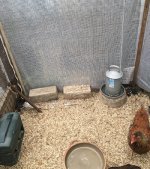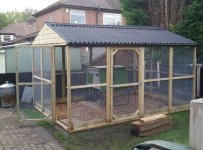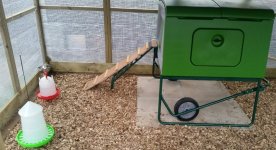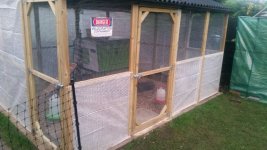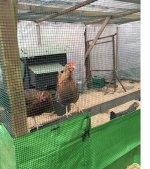Hi again, Fraser. My run is the same size as yours, 3 x4 metres, so here are some pics of mine showing screening etc.
Just a few ideas to share - I’ll be interested to see pics of your setup, as you develop it. Good luck with your project, we hope to hear more soon.
It would be great if we could develop this thread, with pics of how other people have laid out their runs and invented shelter from wind and rain. Lots of ideas to share?

This is the view from the entry, showing the back 1/3 of the run, with two internal screens and a gap between them. The screens are based on old scaffolding supports from a friend’s skip. I’ve made a separate mesh panel that I can fix temporarily across the gap when I need to separate or isolate any of the hens. The dividers also support two feeders, on battens; the light green one contains grit and oyster shell and the dark green one on the other side contains layers pellets. It’s vitally important that the pellets stay dry at all times. The big green tub at the back is the deep dustbath. It’s about 1/3 full of dry soil/sand mix, and the high sides help to prevent the hens from scattering the contents when they stand up to shake their feathers after a good roll in the dust.
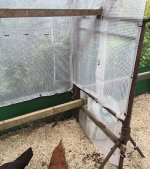
This is the area where they can roost on a high perch at night, dry under the roof and sheltered from wind and rain by tarps fixed round three sides, like an openfronted tent. Plenty of ventilation, but they cuddle up to keep warm. They also have the option of roosting in a normal coop but being young and all from quite flighty breeds, they prefer the perch option - it’s their choice. The overnight droppings fall in a neat pile on to the Aubiose bedding and are easier to pick up next day than cleaning out a coop - and no danger of redmite in the coop, if they never sleep in there. You can see how I’ve fixed the tarps to the mesh in the middle, using cable ties.

This is the view from the back of the run towards the door - the larger area, with the coop and with a long perch overlooking the garden where they sit to watch what’s going on. The low green tarp screens are mainly to prevent the dog from terrorising them - she likes it when they get in a flap. But they also provide a bit of shelter from wind at the hens’ level. Chickens are originally ‘forest edge’ birds and they like to be able to see out but not feel too exposed. The end with the door in it, and the long side with the perch, aren’t covered with tarp, they let in lots of air and keep everything ventilated. That side does get wet in driving rain, but so long as the birds can always find shelter elsewhere, that doesn’t matter. The Aubiose dries out without going mouldy, unlike wood chippings.
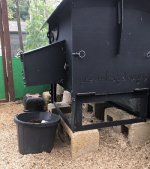
The Green Frog coop is up on blocks, (easier on a human’s back when cleaning it out) and they like to get in underneath for a little communal snooze in the afternoon. I’ve had to raise the gangplank with an assortment of blocks, as you see. That side of the run is covered with tarp as it faces NE and a lot of rain and cold wind blows across the field on the other side. If they did choose to sleep in the coop, the tarp would prevent direct draughts from blowing in the open pophole, which I never shut at night. Also, if it snows, it blows in through the mesh and fills the run if there’s no tarp in place.

This is the other side of the sheltered end at the back. It’s up against a neighbours shed, so rain would be diverted in off the shed roof when it’s wet, but the tarp keeps it out OK and thus keeps the feeder dry. I can’t get to the other side to fix cable ties to hold the tarp flat, hence the blocks at the bottom. The ‘afternoon treats ‘ plate is up on a block so it doesn’t get full of Aubiose when they scratch around. It’s best if they feed off a plate, rather than finding corn etc scattered on the floor where it’s likely to get contaminated by worms from their droppings. The drinker is also on a block, at chest height for the smallest bird, which helps to keep Aubiose out of the water so it stays cleaner than if it was on the floor.






